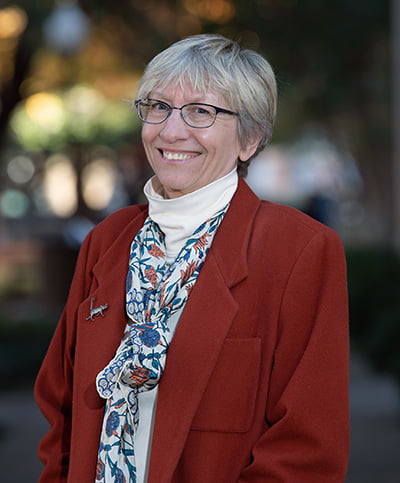1225 W Mitchell Arlington, TX 76019
203 Carlisle Hall Box 19035
T: 817-272-2692 | F: 817-272-2718

Long before COVID-19, Dr. Gyde Martin was teaching a class on the history of cultural responses to pandemics. Recently the Spring 2020 Department of English Promotional Materials Intern, Marie Schreiner, sat down on Microsoft Teams with Dr. Martin to learn more about the course.
How was the class structured?
That’s an easy one. We followed a strict chronological order dictated by the well-documented pandemics that have afflicted humanity over the centuries: the plague or “Black Death” with its multiple outbreaks across Europe, especially in the 14th and 17th centuries; the Spanish Influenza of 1918; and the AIDS crisis of the 1980s.
What genres did you look at?
Whatever genres the writers chose! Many of our texts are nonfiction accounts, often by eyewitnesses, for example, the diaries of Samuel Pepys recording the plague in London in 1665. Or they may be creative nonfiction like Daniel Defoe’s A Journal of the Plague Year written to warn Londoners of a new outbreak some fifty years later. The plague, by the way, remained a favorite among writers of historical fiction long after it ceased to be a threat, and they have put it to interesting uses. Think of The Plague by Camus.
What mediums did you focus on? Any movies or poetry?
Yes, poetry and also stage plays. Both were favorite genres during the AIDS crisis when writers were once again writing in mid-crisis or very shortly thereafter. Some stage plays became movies or television productions later on. So, rather than reading Tony Kushner’s Angels in America , we watched the six-hour television series. We also watched And the Band Played on , a docu-drama to inform us about the early phase of the AIDS crisis.
Did the texts take a historical approach or were they more speculative?
For many of the students, the AIDS crisis is way in the past. It happened before they were born, and although it is still a threat in some parts of the world, it has since been overshadowed by SARS, H1N1, Ebola and ZIKA, not to mention COVID-19. The interesting thing for us to observe is that human behaviors in the midst of a pandemic have changed very little over the centuries, maybe because the sudden outbreak brings us face to face with our mortality long before we think of ourselves as old enough to die. Speculative fiction has had a tremendous boom since the AIDS crisis, both in popular culture and “serious literature.” I think when it comes to serious topics—pandemics, nuclear destruction, or the environmental crisis—popular culture must be taken seriously. It is a very sensitive barometer of our unacknowledged apprehensions. A movie like Contagion deals with the threat of a pandemic head on, that is, in highly realistic terms, but the supernatural has clearly been the favorite in dealing with our apprehensions. Last time I taught this course we watched Contagion and also read World War Z: An Oral History of the Zombie War.
How did you define a pandemic for this class? Did you focus on diseases that spread over a particular country? Or was the focus worldwide?
This a tricky question, trickier than the dictionary definitions make it seem. It depends on how we look at maps and statistics, in particular the death toll. An epidemic denotes a severe outbreak in one geographic area, but how large an area are we talking? One part of one African country or a major part of the African continent? Wouldn’t such a spread call for the term ‘pandemic’? But from a safe distance we, or rather our media, may prefer to call it an ‘epidemic,’ until it moves closer. AIDS, because of its presence on several continents, should be called a ‘pandemic’ but is more often referred to as an ‘epidemic.’ In other words, the perception of threat to oneself may influence word choice here. Needless to say, the media play a major role in influencing our perception of threat. Before I taught this course as a literature course, I used the topic in a freshman composition class for the Honors College where we spent much time analyzing the media reports on Ebola: responsible reporting versus fearmongering.
Did the texts give any sense of comfort or hope?
I believe there is something cathartic for the reader or moviegoer because their unacknowledged fears are brought to the surface if only for the duration of the read or movie and in total safety. Which is much healthier than leaving it bottled up inside. Some of us gravitate toward this experience while others may shun it. We all have our favorite genres and turn to them as part of our coping skills. So, yes, to “comfort.” “Hope” may be a different matter. In some people it “springs eternal”; in others it requires information, solid facts or what passes for facts. Who knows, reading the texts from the past may give hope that life will go on for the human species, though perhaps not for us personally or those we love. And now we are back to the very opposite of hope, namely fear, and that delicate balance between the two with which we speculate about the future.
Are there any texts that you recommend for people who are interested in the topic?
Glad you are asking. Dr Kathryn Warren’s summer reading group will do Stephen King’s The Stand starting May 22. Because of its length, I could never use it in my course, but King deserves special mention for this speculative novel that predates the flood that came after the AIDS crisis. It certainly couldn’t be more topical, and maybe it will be a little cathartic. The meetings will still have to be virtual, but just reading it with others is comforting.